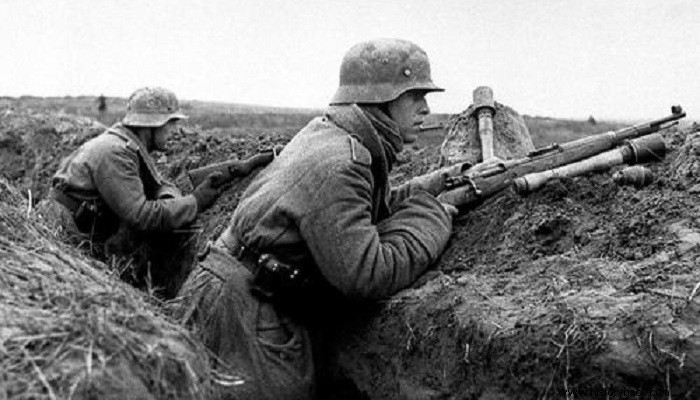
In July 1944 the Soviets launched their largest offensive on the Eastern Front to date, crushing an entire German Army Group. This success convinced the Soviet command that the advance into East Prussia was feasible against the disintegrating German forces. But things didn't turn out exactly like that.
The Soviet forces, having confined the Germans to a narrow strip of land at Memel, turned further south, spearheaded by the 3rd Belorussian Front (army group) under Ivan Cherniakovsky.
Soviet raid
The 3rd Belorussian Front had the 11th Guards Army and the 5th, 28th, 31st and 39th Armies. Directly opposite these forces stood the German 4th Army under General Friedrich Hosbach, an experienced officer. Essentially, the burden of the fight, in the first phase of the battle at least, was borne, on the German side, by the 1st Infantry Division (MP) of the "Prussians" .
At 04:00 on the morning of October 16, 1944, the storm Hosbach had been waiting for broke. For two hours, thousands of shells and rockets hit the German positions, digging them out. However, thanks to the preliminary work that had been done, with the construction of reinforced bunkers and false fighting positions and cannons, the effects of the Soviet preparation were mitigated.
In the sector of the 1st MP, where the organization of the terrain had not been completed, the losses of the German forces were significant. Immediately after this deluge of fire and iron the Soviet forces rushed out. Opposite the 1st MP was the entire Soviet 28th Army. South of it the 11th Guards Army was deployed and further south the 31st Army. Czerniakovski's aim was to attack in three times, starting from north to south, disintegrating the German front.
The Soviets charged furiously against the overextended position of the 1st MP, also supported by tanks. However, they faced the heroic, literally, resistance of the Prussians of this division and were forced to stop. After a fierce fight, they were repulsed, although they were outnumbered by at least 4:1 against their German opponents, as in the attack against the 1st MP, Czerniakovski threw five rifle divisions, two tank brigades and an assault regiment.
Persistence
At first light on October 17, Czerniakovski, despite the initial failure, decided to continue the attack. Hosbach, for his part, reinforced the 1st MP with Captain Hope's 279th Assault Rifle Brigade. The 1st MP, after the heroic defense of the previous one, had retreated slightly and had organized the small town of Shirvid as a support point. The anti-tank battalion of the 1st MP was fortified there, which had 12 Hetzer tank destroyers and six towed 75mm RAK 40 anti-tank guns.
The Soviets, unable to conquer the town, tried to overrun it from the North and South. From the north their forces spearheaded a battalion of T-34 tanks. However, the Soviet attack was drowned in blood , with the German anti-tanks breaking through. Exasperated, the commander of the Soviet 28th Army, General Luchinsky, ordered his 27th Rifle Division, reinforced by the 113th Tank Brigade, to capture the town at all costs.
The Soviets attacked again, but the Germans again defended by all means. Only after a fierce fight from house to house and with very heavy losses, did the Soviets manage to occupy the ruins of the town. The 1st MP retreated but still did not break up, supported by the 279th Assault Rifle Brigade, whose commander was killed. This unit was deployed between Cervid and Schlossberg, supporting the retreat of the 1st MP. There the Germans again put up a strong defense and stopped the Soviets again.
The prey becomes the aggressor...
The serious losses suffered by his forces did not convince Czerniakovski that he should stop the operation. So he decided to try again at the northern edge of the front against the tireless 1st MP, which had, by then, destroyed 130 Soviet tanks and assault guns and covered the battlefield with dead Soviet soldiers.
The Soviet commander ordered his 5th Army to resume its attack, reinforced by the 39th Army. And yet, despite its absolutely overwhelming numerical superiority, the 1st MP managed, for 12 whole days, to repel all Soviet attacks, causing terrible losses to the attackers. The resistance of the heroic 1st MP convinced Hosbach that he could throw his forces without fear against the Soviet enclave around Goldap, Czerniakovski's only serious territorial gain until then. The German counterattack succeeded in encircling Soviet units.
The Soviets attempted to break out of the line, but failed, losing an additional 42 tanks. The trapped Soviet forces continued to fight until November 5, when the survivors also laid down their arms. The Soviets repeated their attack and gradually forced the defenders to retreat, slightly, defending the ground step by step, without succeeding, however, in breaking the lines of the 1st MP.
